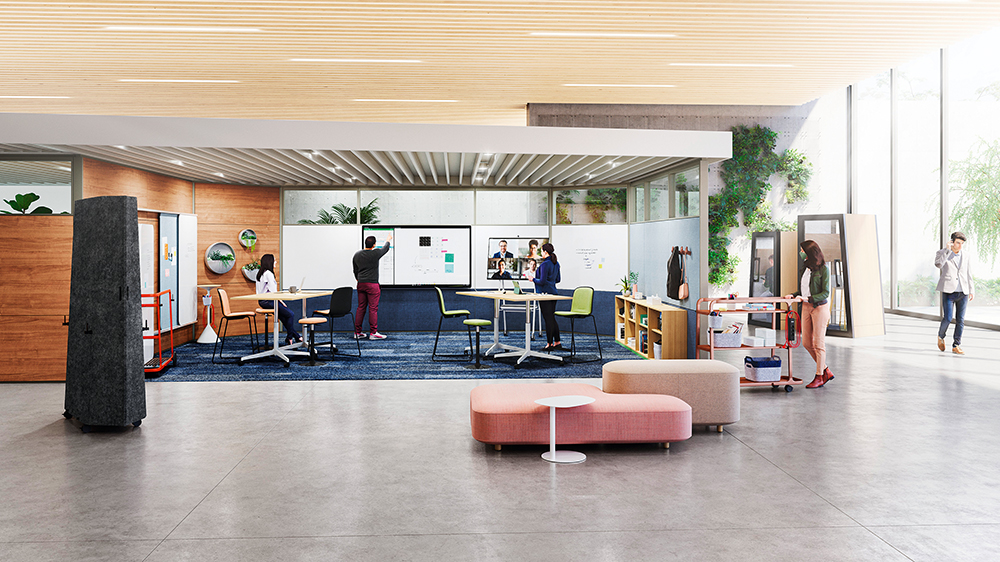Throughout the pandemic, people had to change many aspects of their daily lives, from where they live and how they shop to how they learn and, for many, how they work. Some of these changes are here to stay, and as they become the new normal, we’re called upon to determine what else needs to change, and how, to shape the post-pandemic workplace we want.
Although hybrid work has long been familiar territory for a small minority, it wasn’t until the Covid-19 pandemic that it became a new norm, coming about as a dramatic shift in how work happens for the majority of organizations globally. This new hybrid blend of on- and off-line interactions means that we have to think about the needs of people as they adopt a new way of working, and we must also consider how the workplace and technology need to change to help them be successful.
Concepts like flexibility, mobility, resilience — and the trust these require among people — can be catalysts for new ways of working and can redefine how the office can help people thrive. In a recent Steelcase webinar, 59% of nearly 1,000 attendees said the biggest benefit of hybrid work is the ability to attract and retain talent, while 54% said that the biggest threat is cultural erosion.
Organizations found that reshaping their culture is essential to create new norms for how people will work together going forward
We have all struggled with a feeling of isolation while working from home. Combine that with the sense of whiplash many people feel from the ups and downs of Covid caseloads, return-to-office delays and conditions that seem to change daily, and it’s clear that people’s wellbeing has suffered. Organizations that have returned to the office found that people need to be reenergized and rebuild their “muscle memory” for being in the workplace. They’ve also found that reshaping their culture is essential to create new norms for how people will work together going forward.

The workplace can become an infrastructure for fostering a resilient hybrid culture by providing spaces that not only support increasing collaboration between in-person and remote workers but also help people feel a sense of belonging and connection to their teams and the organization, regardless of location. Steelcase research shows that feeling part of a strong community helps people achieve more and boosts productivity, engagement, innovation and retention. Many leading organizations are making changes before team members return to the office so people can see and feel their organization cares and is taking action to meet their needs in a new era of hybrid work.
Five Things People Need for Hybrid Work:
Safety
People need to know that their organization is doing everything possible to keep them safe and mitigate the spread of disease. Workers are particularly concerned about air quality; 62% of respondents to a recent McKinsey study said that improved air filtration could decrease the stress they experience from returning onsite.
Feeling part of a strong community helps people achieve more and boosts productivity, engagement, innovation and retention
Productivity
Hybrid work will require new spaces and technology to help people be effective. People need places for 1-on-1 or small group video calls, either enclosed or with greater acoustic privacy at their desk. Groups need places that support both in-office and remote participants equally — where everyone can see and be seen, hear and be heard. Spaces should be designed for a better virtual presence with important elements like cameras, acoustics, content, and lighting.
Belonging
In a time where people are working from diverse locations, people need their workplace to help create community and generate the social glue that builds cooperation and team cohesion. Strong communities have a sense of shared purpose, as well as shared leadership. With high levels of trust and engagement, communities allow people to learn, adapt and demonstrate resilience in the face of changing circumstances.
Comfort
Physical comfort is critical for hybrid workers, especially if they are spending a lot of time on video. People’s wellbeing has suffered, and they need places and experiences that help them rejuvenate and reset throughout the day.
Control
Living through a crisis and facing changing ways of working, people crave more certainty. They want to be able to have more choice and control over:
- Where they work within the office
- When they work at the office or home
- How they work, alone and with teammates
Although it will look different for everyone, hybrid work is perhaps the biggest opportunity organizations have to reinvent their culture. People and leaders need to adjust expectations about how work happens, adopt new behaviors and rethink the role of the office going forward.



